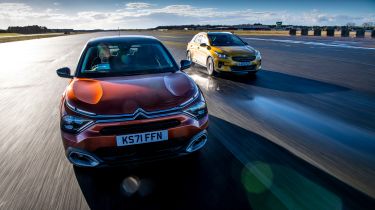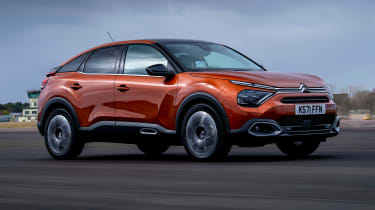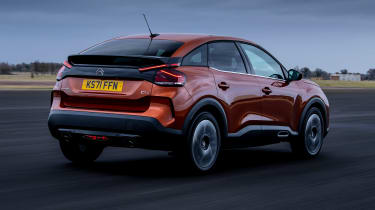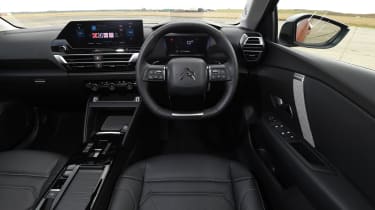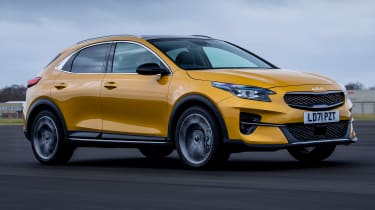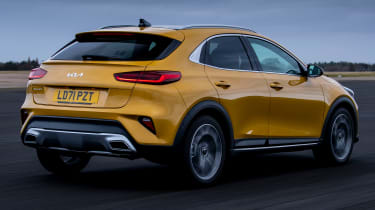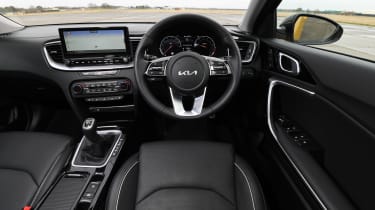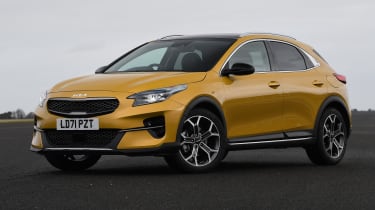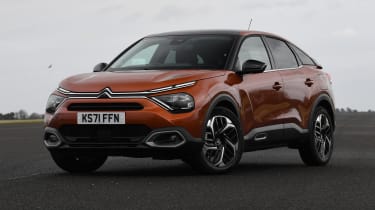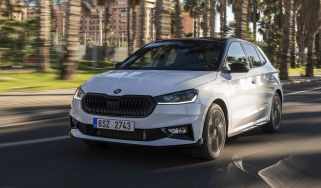Citroen C4 vs Kia XCeed: 2022 twin test review
We find out which high-riding crossover hatchback is best
The new-car market is awash with different niches, but the Citroen C4 and Kia XCeed we’re testing here manage to sit in one of the most specific categories of all.
They’re pretty close to a small family hatchback in terms of size, but both sport a raised ride height and chunky SUV-style cladding. So for example, if you find a regular Volkswagen Golf just a little too sensible for your tastes, but don’t need a car the size of a Tiguan, then these models might be the ideal alternative.
Both cars tested here have the most powerful engine options in their respective line-ups, and they’re well equipped, too. These then, are posh, powerful hatchbacks that think they’re SUVs, yet are as comfortable on a long trip as they are capable around town. But which is best?
Citroen C4
|
Model: |
Citroen C4 Puretech 155 Shine Plus |
|
Price: |
£28,490 |
|
Engine: |
1.2-litre 3cyl turbo |
|
0-62mph: |
8.5 seconds |
|
Test economy: |
45.8mpg/10.1mpl |
|
CO2: |
130g/km |
|
Annual road tax: |
£155 |
While the C4 sits in its own little niche in terms of bodystyle, it also stands out because of the bits you can’t see. In addition to the petrol model that we’re testing here, it’s possible to choose diesel and fully electric powertrains, too.
Then there’s the mechanical layout. While Citroen has long abandoned complex hydropneumatic suspension systems, the brand has turned to a simpler set-up that it hopes will give the C4 a very distinctive feel. We’re testing the top-spec Shine Plus model here with a recent addition to the engine range – a PureTech 155 petrol. This is priced at £28,490 before options.
Used - available now

2022 Vauxhall
Mokka
32,005 milesManualPetrol1.2L
Cash £13,342
2023 Tesla
Model Y Premium
59,537 milesAutomaticElectric
Cash £22,300
2022 MG
HS
20,888 milesAutomaticPetrol1.5L
Cash £16,795
2023 Mercedes
GLA
24,279 milesAutomaticPetrol1.3L
Cash £27,397Design & engineering
After an extended period where Citroen seemed to lose its identity, recent models have started to embrace some of the qualities that made its classic models so desirable. That’s clearly evident just by looking at the C4, whose quirky design ensures it stands out on the road not just beside the XCeed, but also against almost any other hatchback.
Elements such as the scuff-protecting ‘airbump’ plastic cladding prove that some sensible steps have been sought, but true to traditional Citroen oddness, not all of the design decisions seem to have been taken with absolute practicality in mind. Take that bluff back end; the squared-off shape for the bootlid has been garnished with a subtle lip spoiler, which sits right across the tailgate glass, partially obstructing the driver’s rear view. Inside, the C4’s cabin doesn’t quite live up to the distinctive exterior.
The all-black scheme of our test car didn’t help, but the overall layout is fairly conventional. It looks more modern than the Kia’s dash, though, and there’s not much in it in terms of build quality. A triple- decker cubby at the base of the dashboard features a wireless smartphone charging pad on its upper level, while below there’s a small hidden space beneath the hinged middle shelf. The useful touches are capped off with an iPad holder on the passenger side of the dashboard; the framework holds the device securely in use, and it slots neatly away in a dashboard drawer when it isn’t needed.
One quality that Citroen has chosen to try to reconnect with models of old is comfort. To that end, the C4 features specially padded seats, which use several different foam materials in the cushioning to provide a variety of body types the maximum comfort. They feel very soft, although the wide, fairly flat backrest and base don’t offer too much side support when cornering.
That softness also extends to the C4’s ride comfort. Here, Citroen has installed hydraulic bump stops all round on the suspension, which allow the springs and dampers to be softer while preventing the car from bottoming out. It really works, too; there’s a relaxed gait to the suspension settings that – other Citroen models aside – is quite unlike anything else at this price point. The set-up is at its best on A-roads, where a steady cruise brings out the best of that softness. On the downside, it does mean that under hard acceleration and braking, the body rocks back and forth on its springs, and at higher speeds, the marginally firmer set-up of the Kia means that car feels more secure.
Driving
At 1,299kg, the C4 is 100kg lighter than the XCeed. That results in lively performance. The three-cylinder engine is quieter than the XCeed’s four-cylinder, although its rival transmits fewer vibrations through the cabin.
While the eight-speed auto is smooth on the whole, it’s very clumsy in traffic, making the C4 almost impossible to bring to a gentle halt. Steering-wheel paddles allow manual control for more spirited driving.
Practicality
Knee room in the C4 is very generous, and the light roof lining and large sunroof make it feel airy. The extra rear quarter glass helps over-the-shoulder visibility, so its blind spots are smaller than the Kia’s.
At 380 litres, the C4’s boot is a decent size. There isn’t much wheelarch intrusion into the space, and a level loading lip means that it’s fairly easy to haul bulky items inside. While the back rest lacks the three-way split of the XCeed, the Citroen does have a ski hatch. Isofix child seat mounts are hidden behind zipped covers; the Kia has removable plastic covers, which make the fixings easier to connect.
Ownership
While Citroen’s dealers didn’t feature in our 2021 Driver Power survey, Kia once again excelled, with its network ranking 3rd of the 21 brands. Its sales team and the standard of work from mechanics both received praise.
There’s little to separate the two when it comes to insurance cover; our representative annual quote returned a figure of £385 for the Citroen and £399 for the Kia.
Running costs
The C4’s lower kerbweight also helps running costs. Our 45.8mpg seemed quite easily achievable in a variety of conditions, and at 133g/km, CO2 emissions are 10g/km lower than the XCeed’s, too.
Neither car offers strong residuals, but the Citroen is the better of the two. After three years, it clings on to 43.7 per cent of its original value, which compares well with the Kia, which holds 40.7 per cent.
Kia XCeed
|
Model: |
XCeed 1.5 T-GDi 4 |
|
Price: |
£29,080 |
|
Engine: |
1.5-litre 4cyl turbo |
|
0-62mph: |
8.7 seconds |
|
Test economy: |
42.9mpg/9.4mpl |
|
CO2: |
143g/km |
|
Annual road tax: |
£155 |
The Cee’d name was introduced in 2006 with the Mk1 family hatchback, which was originally positioned as a rival for the VW Golf. Two generations later – and minus the apostrophe – the Ceed is now more than capable of matching the best in the class, and there are four bodystyles to choose from: the five-door, estate, rakish Proceed shooting brake and this SUV-inspired XCeed are now available.
Until recently, Kia offered a dual-clutch automatic XCeed. While this would have been perfect against the C4, Kia has stated that a mix of “unprecedented demand” and “new supply challenges” means it’s not currently offered, so we’re testing a manual XCeed here.
Design & engineering
Of the four models that make up the wider Ceed family, it’s the XCeed that looks the most distinctive from the outside. Indeed, the front doors are the only outer panels that are shared with the rest of the line-up, while the car’s overall silhouette, and details, such as the head and tail-lights, are quite a departure from its namesakes.
As with the C4, this includes a mildly jacked-up stance to give a crossover flavour, but the XCeed’s shape is softer and less challenging than its rival’s, and that will probably help it to find favour with a lot of buyers.
Inside, the dashboard layout is near identical to the rest of the Ceed range. While there isn’t much to fault in terms of build quality, the general layout is starting to look a little dated. As with the Citroen, Kia has equipped the XCeed with a smartphone shelf with wireless charging. There’s also a pair of cup-holders up front (not quite as deep as the C4’s) and a giant, cube-shaped enclosed bin between the front seats. While the French car’s glovebox is tiny – a result of housing the fuse box in the same area – the Ceed’s is very generous, as are its door bins.
The one downside is visibility, because the car’s large C-pillars mean that there’s a big blind spot; the C4 has slim rear quarterlights, which help.
One area where the XCeed is streets ahead of its rival is in terms of the infotainment tech. Kia hasn’t done anything radical here – and that’s a good thing. You get a large, clear screen, a main menu page with two rows of icons, logical sub-menu structures and decent loading times. While older Kia set-ups had physical shortcut buttons, these have now been replaced by a row of touch-sensitive keys, which are still large enough to use fairly easily.
Functions for the digital dials are found on the steering wheel and, again, their layout is easy to figure out. They offer more customisation than the small and rather basic digital array in the C4, too. Overall, the system is so much friendlier to work out than its rival’s baffling interface.
While mechanically similar to the Ceed hatchback, the XCeed sits higher, thanks to a 20mm increase in ride height, plus slightly chunkier tyres. This doesn’t vastly change the way that it behaves, but it does mean is that, in this company, the XCeed is a much more engaging option to drive. While a slightly firmer (but in no way uncomfortable) suspension set-up that delivers better body control certainly plays a part in this, it’s the steering that really makes the difference. Where the C4’s rack is vague and overly light, the Ceed’s is precise, and it loads up naturally when turning into a corner.
Driving
Kia’s 1.5-litre petrol is up by 5bhp and 13Nm on Citroen’s 1.2, but on paper takes 0.2 seconds longer to get from 0-62mph. The XCeed’s power delivery feels more linear than the C4’s, whose peak torque arrives in a sudden shove.
Six–speed manual shifts through the gate nicely enough, but the clutch pedal is light and the biting point is vague, so it’s hard to move away cleanly. The start-stop system engages much more smoothly than the C4’s.
Practicality
The XCeed’s 426-litre boot volume pips the C4’s 380-litre capacity, and space grows to 1,378 litres with the seats down. Top-spec 4 trim gets 40:20:40 split folding, the lower 3 model has a less versatile 60:40 split.
In the back, the Kia isn’t quite as spacious as the C4 when it comes to kneeroom, but taller occupants will find a little more headroom. The hump in the centre of the floor is much smaller than the Citroen’s, but there’s not much foot room under the front seats. A panoramic sunroof is standard on 4 trim. While it lets in plenty of light, it only opens halfway – although the same is true of the C4’s roof.
Ownership
For peace of mind, Kia’s seven-year/100,000-mile warranty should rightly be a big draw for buyers – and will make the car more attractive for used buyers, too. Citroen’s cover is less comprehensive, at three years or 60,000 miles, whichever comes first.
Kia took a brilliant second place in the 2021 Driver Power manufacturer’s category. In contrast, Citroen finished a poor 28th out of 29.
Running costs
Both cars achieved mid-forties mpg, but the Citroen’s 45.8mpg figure gave it a 2.9mpg advantage over the Kia. This translates into a £214 saving over 20,000 miles, based on petrol priced at £1.59 per litre.
The Kia’s CO2 emissions are slightly higher than the Citroen’s. As a result, it sits one tax band higher, which for lower-rate company car drivers means annual deductions of £3,802 – £191 more than the C4.
Verdict
First place: Kia XCeed
While both cars operate in a niche segment, they each have their own distinct appeal. The Kia wins, though, because the trim we’d have is much cheaper than the Citroen, and the XCeed is likely to be a more pleasing ownership prospect, with fantastic tech, a big boot and a decent drive.
Second place: Citroen C4
The C4 has helped Citroen rediscover some of its quirkiness, and for some that will be reason enough to buy. It’s comfortable, spacious and slightly cheaper to run than the Kia. However, this isn’t the trim or engine we’d choose; the C4’s appeal lies at the more affordable end of the range.
